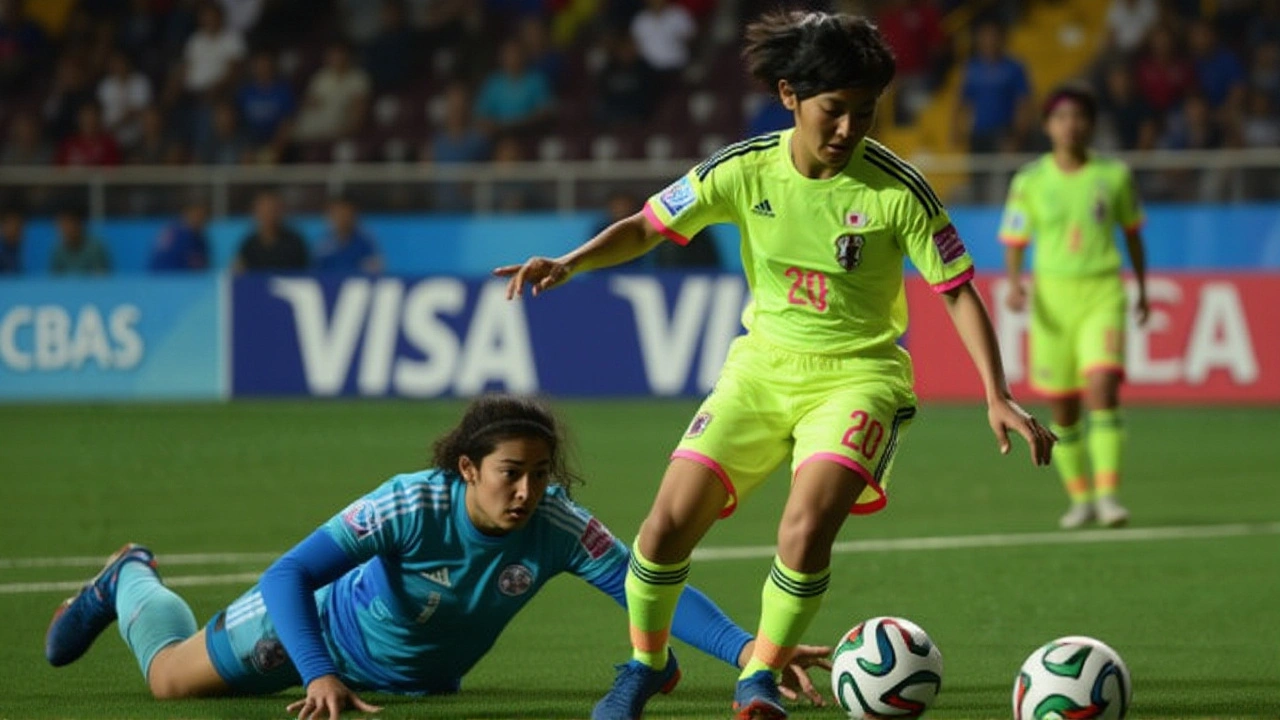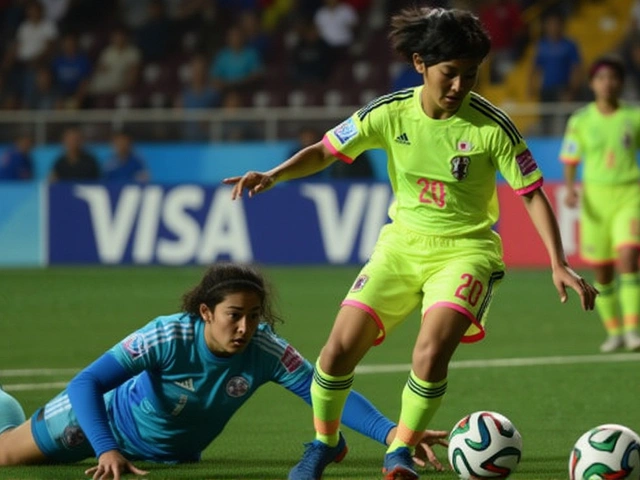
When Hina Sugita, captain of Japan U‑17 Women’s National Team lifted the trophy on her head for a third time in a single match, the roar at Ricardo Saprissa Aymá Stadium was deafening. The Young Nadeshiko smashed Paraguay 10‑0 on March 20, 2014, clinching a quarter‑final berth with a match to spare in the 2014 FIFA U‑17 Women’s World CupCosta Rica. Head coach Asako Takakura, who guided the squad from the bench, could barely contain her grin as the tenth goal ticked the scoreboard in stoppage time.
Background: The 2014 U‑17 Women’s World Cup in Costa Rica
The tournament, hosted across six venues from March 15 to April 4, marked the first time Central America staged a FIFA women’s youth finals. After a rocky bid process—FIFA briefly stripped Costa Rica of hosting rights in early 2013—the nation secured the event with guarantees from CONCACAF and the local government. Attendance surged, with a record‑breaking 34,453 fans witnessing the opening match, and a total of 284,320 supporters watching the 32 games (averaging 8,885 per match). FIFA touted the tournament as a showcase of the next generation of talent.
Japan’s 10‑0 rout: How the match unfolded
From the first whistle, Japan imposed a relentless tempo. Midfielder Yui Hasegawa opened the scoring in the 15th minute, cutting the Paraguayan defense wide open. Seven minutes later, forward Yu Endo doubled the lead, and by halftime the Japanese side already commanded a 3‑0 advantage thanks to a third strike from Asato Miyagawa.
The second half was a goal‑fest. Forward Nana Ichise netted the 4‑0 right after the break, followed by midfielder Maki Hiratsuka at 56 minutes and defender Mizuki Saihara at 62 minutes. Then, Japan’s skipper Hina Sugita completed a second‑half hat‑trick (65’, 72’, 80’), cementing her status as the night’s star. A penalty by forward Fuka Kono sealed the ninth goal, and an own‑goal in stoppage time rounded the tally to ten.
Heroes of the day: Goal‑scorers and key performances
- Hina Sugita – 3 goals (captain’s hat‑trick)
- Yui Hasegawa – 1 goal
- Yu Endo – 1 goal
- Asato Miyagawa – 1 goal
- Nana Ichise – 1 goal
- Maki Hiratsuka – 1 goal
- Mizuki Saihara – 1 goal
- Fuka Kono – 1 penalty
- Own‑goal – credited to Paraguay
Seven different Japanese players crossed the line, a testament to the team’s depth. Goalkeeper Riko Ueki (who kept a clean sheet) made a handful of decisive saves, especially when Paraguay mounted a brief flurry in the 70th minute.
Official reactions and fan excitement
“We expected a solid performance, but the margin is extraordinary,” said Kazuo Sano, spokesperson for the Japan Football Association. “This shows our youth programme is bearing fruit, and the squad is ready for the knockout stage.” The JFA’s President, Kozo Tashima, posted a celebratory tweet that quickly trended in Japan, highlighting the team’s unity and the tactical acumen of Coach Takakura.
Paraguayan coach Javier Pérez admitted the result was “a harsh lesson” but praised his players for showing resilience amid a superior opponent.
What the early qualification means for Japan’s title chances
By securing a quarter‑final slot with a game to spare, Japan can rest key players ahead of the New Zealand match on March 23, giving Coach Takakura the luxury to fine‑tune tactics. Analysts from the Asian Football Confederation (AFC) note that early qualification often correlates with deeper tournament runs, as teams avoid the fatigue of last‑minute scrambles.
Indeed, the Young Nadeshiko rode this momentum all the way to the final, defeating Spain 2‑0 on April 4 at the Estadio Nacional in San José, and becoming the fourth different champion in the competition’s four‑edition history.
Frequently Asked Questions
How did Japan’s victory affect Paraguay’s chances in the group?
Paraguay’s ten‑goal deficit meant they fell to bottom of Group C with zero points, ending any realistic hope of advancing. Their next match against New Zealand became a formality, and the team shifted focus to gaining experience for future tournaments.
What tactical changes did Coach Asako Takakura make after the first half?
Takakura swapped a defensive midfielder for an extra attacker at the 46‑minute mark, pushing the team into a 4‑3‑3 formation. This aggressive shift unlocked space on the wings, allowing players like Nana Ichise and Maki Hiratsuka to exploit gaps and add to the goal tally.
Why was the match’s attendance notable?
Over 8,200 spectators filled the stadium, making it one of the most‑watched group‑stage games of the tournament. The crowd’s energy was cited by players as a factor that amplified Japan’s attacking confidence.
What does the early qualification suggest for Japan’s preparation ahead of the quarter‑finals?
With one group match left, the coaching staff can rotate the squad, reduce injury risk, and conduct focused training on set‑pieces—areas that proved decisive in later knockout games.
How does this performance compare to Japan’s previous U‑17 World Cup outings?
The 10‑0 win set a new record for goal margin for Japan at any FIFA women’s youth tournament, eclipsing the 6‑0 victory they recorded in 2010. It underscored a rapid evolution in the nation’s development pipelines.







Seeing Japan crush Paraguay like that is a textbook case of talent overload. The way the Young Nadeshiko rattled off goal after goal felt like watching a fireworks display on steroids. Honestly, the opposition didn’t even stand a chance once the midfield started spitting passes. It’s almost insulting to call it a "match" when the scoreline reads like a grocery list of scorers. Still, kudos to the squad for keeping their composure and not turning it into a circus.
One cannot overlook the strategic depth that underpinned this overwhelming victory. The decision to shift to a 4‑3‑5 formation after halftime was not merely aggressive but also demonstrative of Coach Takakura's adaptability. By widening the wings, the team leveraged the speed of players like Ichise and Hiratsuka, creating corridors that Paraguay's defense could not seal. Moreover, the distribution of goals across nine distinct Japanese players underscores a well‑rounded offensive program, rather than reliance on a single star. This breadth of contribution is indicative of a developmental pipeline that cultivates versatile talent. The steadfast performance of goalkeeper Ueki, who maintained a clean sheet despite occasional pressure, further solidified the team's dominance. In a broader context, such a result augurs well for Japan's prospects in the knockout stages, where tactical flexibility will be paramount. It also serves as a morale booster for the entire youth system, inspiring upcoming cohorts to emulate this collective excellence. While the margin may appear excessive, it reflects a convergence of preparation, execution, and psychological fortitude that cannot be dismissed as mere luck.
The margin is absurdly one‑sided.
Indeed, a ten‑goal drubbing does raise eyebrows, yet it also highlights a disparity in developmental resources. While Paraguay grapples with limited infrastructure, Japan's system benefits from a meticulously crafted academy network. Consequently, the result is less a surprise and more a manifestation of systemic advantage. Still, the sheer efficiency displayed on the field cannot be ignored.
From a cultural perspective, this triumph showcases how Japanese discipline intertwines with creative flair. The fluid passing and coordinated pressing reflect values of harmony and perseverance that are deeply rooted in our society. It’s fascinating to see how these principles translate onto the global stage, inspiring fans worldwide.
While the cultural angle is nice, the reality is simple: Japan's players are just better technically.
Let us not forget that this is a moment of national pride, a testament to our country's relentless pursuit of sporting excellence. The image of our young warriors dominating the field can stir the very soul of every patriot. It is not merely a game; it is a showcase of Japan's indomitable spirit. The sheer number of goals reflects the fire that burns within our youth, a fire that has been kindled by generations of dedication. Every pass, every sprint, every strike is a ripple in the ocean of our collective ambition. When Hina Sugata lifted the trophy, she lifted the hopes of a nation yearning for recognition on the world stage. The tactical adjustments made at halftime were a masterstroke, revealing a strategic mind that rivals any senior coach. Moreover, the distribution of goals among nine different players illustrates a depth of talent that can only be described as overwhelming. The defensive solidity, highlighted by a clean sheet, further cements the team’s comprehensive superiority. In the grand tapestry of football history, this match will be remembered as a beacon of what can be achieved when unity, discipline, and passion converge. Let this serve as a reminder that Japan, once again, stands tall among the footballing elite, ready to conquer any challenge that lies ahead.
That’s a poetic take, but let’s ground it: the shift to a more attacking formation after the break opened up space, allowing those wingers to exploit gaps. It wasn’t destiny; it was clever coaching and execution.
Cool to see Japan blowing up the scoreboard like that. Shows what good training can do.
Sure, it’s “cool,” but let’s not pretend the opposition didn’t bring a wooden spoon to the game.
Analyzing the statistics, Japan’s possession exceeded 70%, and they completed over 500 passes with a 92% accuracy rate. This efficiency, combined with a disciplined defensive line, created a platform for the attacking unit to thrive. The diversity of goal scorers also highlights a balanced squad where every player feels confident to step up.